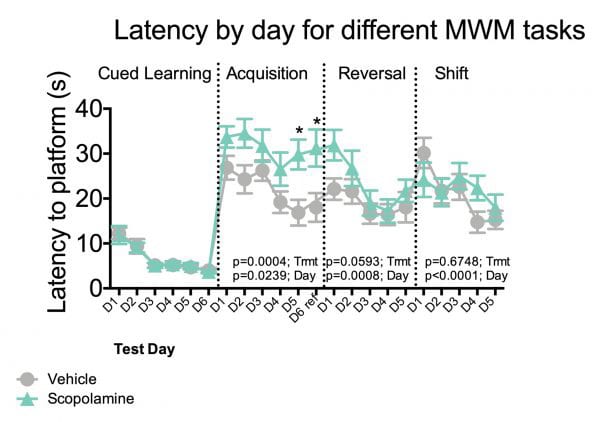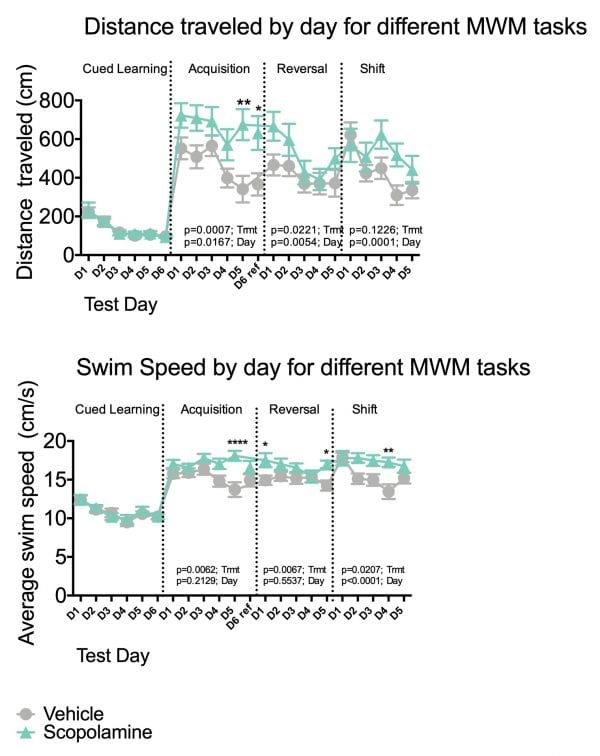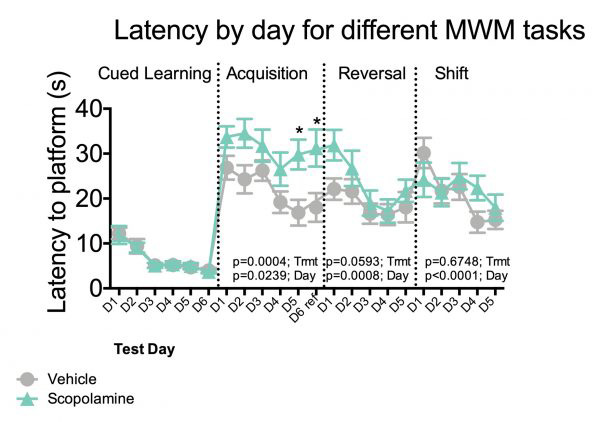Morris Water Maze Test
Discover how Melior’s unique phenotypic screening platforms can uncover the untapped value of your candidate therapeutic
The Morris Water Maze Test is a cognitive task used to evaluate therapies for learning and memory using visual spatial navigation (Morris 1984). Rats or mice are released in a circular pool filled with water. They can escape by swimming to a platform that is hidden beneath the water surface.
In the standard place learning version of the test, the platform remains in the same location and, over a series of trials, the animal learns to locate this platform by using spatial cues that are in the room thus testing the spatial learning and memory of the animal. Learning is measured by latency or distance to find the hidden platform and learning rates can be assessed by examining the learning curves over several days.
Once the place learning task has been mastered, additional variants of the test include reversing or shifting platform location to a new area of the pool. This new platform location tests the animal’s cognitive flexibility and ability to learn new spatial problems. For each platform location, animals receive probe or transfer trials to assess reference memory for the platform location
Performance in the Morris Water Maze Test can be disrupted by pharmacologic or genetic manipulations that produce a cognitive deficit, such as cholinergic or NMDA receptor antagonists (e.g., scopolamine and MK-801 respectively) and/or genetic animal models (e.g., transgenic mouse models of Alzheimer’s disease).
The study summarized below illustrates the spatial learning and reference memory of normal C57BL/6 mice in the Morris Water Maze. Mice were assessed for their ability to learn the location of a hidden platform (Acquisition) and subsequently to re-learn two new platform locations (Reversal and Shift). During hidden platform spatial learning phases, vehicle treated C57 mice were also compared to mice under a pharmacological challenge of scopolamine (1mg/kg).
*p<0.05 vs Vehicle, Sidak post hod following 2-w ANOVA
Cued Learning – Visible Platform. Animals were dosed with vehicle 15 minutes prior to their first training trial each day. The platform was visible to the mice by being raised approximately 1 cm above the water surface. Additionally, a metal flask holder was placed on the platform as a ‘flag’ to further render the platform visible to the mice.
Place Learning (Acquisition) – Hidden Platform. Animals were dosed with either scopolamine (1 mg/kg, IP) or vehicle 15 minutes prior to their first training trial each day. On probe days, all animals were dosed with vehicle only.
Reversal – Hidden Platform. Once the place learning task was completed, animals underwent a reversal task to evaluate cognitive flexibility. The platform location was moved to a 2nd location. Animals were dosed with either scopolamine (1 mg/kg IP) or vehicle 15 minutes prior to their first training trial each day. On probe days, all animals were dosed with vehicle only.
Shift – Hidden Platform. After learning the shifted platform the platform was again shifted to a 3rd location to further evaluate cognitive flexibility. Animals were dosed with either scopolamine (1 mg/kg IP) or vehicle 15 minutes prior to their first training trial each day. On probe days, all animals were dosed with vehicle only.
Probe Trials. For each platform location, animals receive probe or transfer trials to assess reference memory for the platform location. Twenty four hours after the last training session in each platform location, the platform was removed and the amount of time the animal spends in the target quadrant is quantified. On probe days, all animals were dosed with vehicle only.
*p<0.05, **p<0.01, ****p<0.0001 vs. Vehicle, Sidak post hoc following 2-w ANOVA
For the scopolamine-treated mice, the increased latency to find the platform was not due to motor impairment, as scopolamine generally increased the swim speed during training. Both scopolamine and vehicle-treated animals were able to learn the platform’s location over the training days, exhibited by decreased latencies and distance to the platform over time. The vehicle animals learned more quickly and displayed steeper learning curves compared to scopolamine treated mice, thus vehicle animals were able to find the platform in a shorter period of time despite having slower swim speeds.
*p<0.05, **p<0.01, ***p<0.001, ****p<0.0001 vs. Target Quadrant, Dunnett’s post hoc.
Animals that had received scopolamine spent significantly less time in the target quadrant compared to mice that had received vehicle. This was true for all three learning phases. This illustrates that, although the scopolamine-treated animals were able to learn platform location they did not retain this memory as well as vehicle-treated animals.
References
Morris R. Developments of a water-maze procedure for studying spatial learning in the rat. Learn Motiv 1984; 11:47-60



